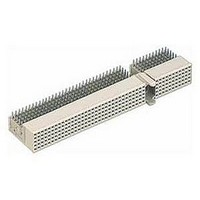17 26 220 2101 HARTING, 17 26 220 2101 Datasheet - Page 10

17 26 220 2101
Manufacturer Part Number
17 26 220 2101
Description
HARD METRIC CONNECTOR, RECEPTACLE 220POS
Manufacturer
HARTING
Series
Har-bus HMr
Datasheet
1.17_33_000_4102.pdf
(56 pages)
Specifications of 17 26 220 2101
Row Pitch
2mm
Pitch Spacing
2mm
No. Of Contacts
220
Gender
Receptacle
Contact Termination
Right Angle Press Fit
No. Of Rows
5
Connector Type
Hard Metric (HM)
Lead Free Status / RoHS Status
Lead free / RoHS Compliant
CompactPCI
and enhanced by the PCI Industrial Computer
Manufacturers
a combination of the electrical and logical
specifications of the PCI standard and the
mechanical specifications of the IEEE 1101 and
IEC 60297 series of standards. The board
connector has been developed from the IEC 61076-
4-101 series of 2.0 mm connectors. The mounting
location and dimensions for the 2.0 mm connectors
are specified in IEEE 1101.11. Some additional
mechanical definitions for 2.0 mm connectors in
the Eurocard format are being specified in the VITA
30 draft.
Other international standards are listed in the
CompactPCI
related specifications. This gives CompactPCI
a solid foundation of international standards and
practices for mechanical robustness.
The board format is either a 3U or a 6U Eurocard
as defined in IEC 60297. There are two or
five connectors specified for 3U or 6U boards
respectively. Connectors
J1/P1 through J5/P5 (bottom to top) on the board
or backplane.
®
®
standard for environmental and
as a standard is maintained
Group
160 mm
110 Pins, Type B
110 Pins, Type B
95 Pins, Type B
110 Pins, Type A J4
110 Pins, Type A J1
(PICMG
are
CompactPCI
22
19
22
numbered
®
J5
J3
J2
).
100 mm
It
233.35 mm
defines
from
®
®
– general information
Slave or peripheral boards need J1/P1 as a
minimum, master or system boards need both
J1/P1 and J2/P2 as a minimum. Backplanes
should always have the full complement of
bottom
the connector are numbered from top to bottom
(according to the IEC standard).
The front panel of CPCI cards may be equipped
with additional keying pegs to code individual board
types. There is also an extended pin length to
remove any electro static charge before contacts
on the rear connnectors mate.
This pin also functions as a mechanical guide
to position the board as straight as possible for
insertion. This prevents pin bending and lowers the
insertion force.
Some applications could require up to 500 pins to
be pushed into sockets simultaneously.
Connectors for high availability applications (hot
swap) come with 3 different lengths of pins for a
staged sequence of mate or break of contact.
Connector J1/P1 carries the signals for a 32 bit PCI
bus (see table of contact assignments for J1/P1).
Connector J2/P2 on a system card has the
additional signals for a 64 bit PCI bus and
some user-defined I/O (see table of contact
assignments for J2/P2). On slave cards all
of J2/P2 might be user-defined I/O except
the top row which carries the signals for
geographical
be reserved for other system bus definitions. J4/P4
and J5/P5 are used for I/O or secondary buses,
e.g. H.110 in telecom applications or for bridges
into other buses like VMEbus.
This is used to accommodate two bus platforms in
one card cage on one backplane.
CPCI
to
any type of board. As opposed to the
top),
standard
connectors to be compatible with
addressing.
the
(pins
contact
numbered
J3/P3
numbers
should
from
on
11
09
















